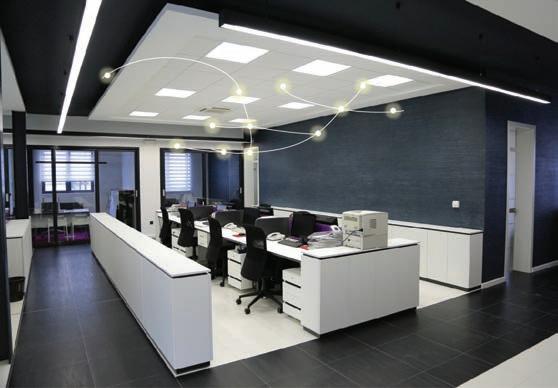
4 minute read
Christopher Dawes discusses the impact LED technology is having on the lighting industry, and looks ahead to some of the further advances we can expect
from ECN July 2020
THE LED REVOLUTION IS JUST GETTING STARTED
ChristopherDawes, Director of NET LED, discusses the impact LED technology is having on the lighting industry, and looks ahead to some of the further advances we can expect in the future.
Advertisement
Wireless lighting sys tems are quick and simple to install and most can be used with a brand-new lighting ins tallation O ver the last decade, LED technology has revolutionised the lighting industry worldwide across the industrial, commercial and domestic sectors. The commercial savings from lower power consumption, longer life expectancy and lower maintenance costs, whilst maintaining the same lighting levels, have been the main drivers for this change. So, have we gone as far as we can with LED? Absolutely not!
Commercial lighting makes up the UK’s largest market sector at over 40%, with LED refurbishments in retail premises, commercial buildings and street lighting driving rapid growth over recent years. These market opportunities have attracted many new companies to enter the market and increased price competition.
Unfortunately, some companies with little or no experience in lighting or LED technology have seen the opportunity to buy low cost Chinese manufactured LED lighting and undercut the professional suppliers for whom safety, performance and brand reputation are essential. The UK’s Lighting Industry Association, along with other more general regulatory bodies, are tackling this issue, but its occurrence is widespread, so purchasing from reputable suppliers is advisable.
The crisis of global warming, largely brought about by the burning of fossil fuels, encourages ongoing research and development into more sustainable solutions across all industries, including lighting. How efficiently LEDs produce visible light, or luminous efficacy, measured in lumens per Watt (Lm/W), is being improved continually. Even though the legal need for energy labels on commercial LED luminaires has been removed, the actual requirement for meeting minimum efficacy levels has not diminished. In fact, it has gone the other way.
A 50% reduction in energy consumption The new Lighting Energy Label Regulations set out targets over the coming years that will require manufacturers to improve their products if they wish to achieve Class A in the future. The current Class A+++ is for products operating at greater than 85 lm/W; the new Class A will need to be greater than 210 lm/W!
That’s an improvement of over 100%, which for lighting users translates into a further 50% reduction in energy consumption – halving the existing running costs. Achieving this efficacy target will further encourage the adoption of LED technology for the refurbishment of buildings, replacing conventional lighting technologies and previously installed LED lighting, as the payback period will have halved.
The lighting industry is confident that these increased energy savings can be achieved with little or no increase in manufacturing costs, as the technology and efficiency of the LEDs and the LED drivers continues to improve.
Using current LED technology, no luminaires are expected to be in Energy Class A or B for some years; but these classes are already in place for when the technology arrives. NET LED Lighting in Cambridge manufactures and sells state-of-the-art commercial LED lighting to electrical wholesalers. Its luminaires’ current lm/W is between 100 and 140 lm/W, so progressing well on the way towards the higher classes.
LED technology has the potential t o reduce energy consumption by up to 50%, which could result in some massive savings
At these efficacy levels, the lighting sold today qualifies for the UK Government’s Enhanced Capital Allowance scheme.
Motion sensors and wireless control As technology has developed, sensors and controls operating in conjunction with LED lighting have been introduced. Motion sensors triggering the lighting to turn on or off, or to stay in a dimmed mode – according to movement and occupancy – can further enhance energy savings. Photocells which detect ambient light can also be used to control the brightness of the LED lighting; harvesting daylight to be able to reduce the LED light output and hence save more.
More recently, we are seeing the adoption of smart, wireless technology being used with LED lighting, bringing new business opportunities. Systems such as the Tridonic basicDIM wireless control technology allows users to simply and wirelessly take control of their lighting – for example, turning on or off up to 250 luminaires around their premises with one switch, making life easy when opening up and closing down at the beginning or end of the day.
Zones can be conveniently created for specific rooms, or sections of rooms, allowing the lighting to be pre-set to particular brightness and colour temperatures, which can then be adjusted according to specific requirements at the time. Dimming specific luminaires, or complete zones, is as simple as holding a finger on a button.
Wireless lighting systems, using technologies such as Bluetooth, are quick and simple to install and most can be used with a brand-new lighting installation or provide an ideal solution for updating conventional lighting.
The possibilities with LED lighting have only just begun. More energy efficient LED technologies with smarter lighting controls are continually being developed, opening massive opportunities for the lighting industry.
NET LED, netled.co.uk
FIRE DEFIANT & REGS COMPLIANT OVIA ® , YOUR LONG TERM TRUSTED PARTNER FOR FIRE RATED DOWNLIGHTS. COMPLIANT IN ALL CEILING TYPES: SOLID TIMBER | I-JOIST | METAL-WEB












